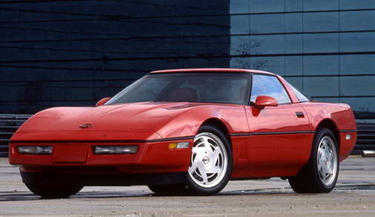Vette News - Corvette: Milestones & More - C4
Over its 60-odd-year run, the Corvette has largely stuck to its original objective of providing homegrown performance wrapped in a stylish, two-seat package. Its journey has at times been an uncertain one, but now in its seventh generation, it's safe to say the hits have outnumber the misses. Here's our look at the Corvette story from conception to the C7. This is article four in a series of seven.

C-4: 1984 - 1996
1984: Chief engineer Dave McLellan finally starts fresh with a new and smaller-perimeter frame, forged
aluminum control arms, power rack-and-pinion steering, and a slippery exterior. The Stingray name goes into
hibernation, where it slumbers next to-initially at least-powerful engine options. Introduced in March 1983,
the C4 features 205 horsepower, 290 lb-ft of torque, a one-piece removable roof panel, and digital instruments.
Drag coefficient clocks in at a claimed 0.34, 24-percent more efficient than that of its predecessor.
Our road-test report by Brock Yates calls attention to the 0.90-g skidpad grip (then a C/D record), phenomenal braking,
sub-seven-second 0-60 acceleration, and 138-mph top speed. "This is a dead-serious sports car," writes Yates. "It defers
to the bizarre only with its video-game instrument panel, which features all manner of multicolored, liquid-crystal bar
graphs, and digital displays in metric and English." The base price is $21,800, and 51,547 1984 Vettes are produced.
1985: The second-year C4 debuts tuned port injection on the 5.7-liter V-8, boosting horsepower to 230.
39,729 1985 coupes are built, 16 with the optional AM/FM Citizens Band radio.
1986: The convertible model returns after a 10-year absence, and serves as a pace car for the Indy 500.
All 7315 1986 convertibles are in fact "pace-car replicas," with the decals included for dealer or owner installation.
Antilock brakes (ABS) are standard.
1987: Horsepower climbs to 240 thanks to roller valve lifters. A new Z-52 suspension option is available on
1987 Corvettes for all-around ride and handling improvements. A Callaway twin-turbo setup is sold through select dealers
as option "RPO B2K" for a cool $19,995. The blown cars produce 345 hp and 465 lb-ft of torque.
1988: New dual-piston front brakes appear as standard kit, and 2050 35th Anniversary Editions are produced.
Chevy also builds 56 street-legal cars for the 1988 SCCA Corvette Challenge race series.
1989: A jointly developed ZF/Chevrolet six-speed manual replaces the Doug Nash 4+3 manual transmission.
Chevy begins dropping ZR-1 hints. 26,412 1989 models are produced.
1990: The Corvette ZR-1 debuts, sporting a 5.7-liter V8 capable of 375 hp. A Lotus/Chevrolet design,
the engine boasts four camshafts and 32 valves, and is assembled by Mercury Marine in Stillwater, Oklahoma,
before being shipped to Bowling Green for final assembly. The $27,016 ZR1 price nearly equals the base car's
$31,979 MSRP. 3049 ZR-1s are produced. In the shadow of the ZR-1's hubbub, a driver's-side airbag becomes
standard, and ground is broken at the National Corvette Museum in Bowling Green, Kentucky, in June 1990.
1991: The first major restyle since 1984 adds ZR-1-style exterior bits to the 1991 Corvette coupe and
convertible. Finned power-steering coolers are introduced and the Corvette ZR-1 beats the 911 Turbo in a
comparison test we published in April 1991 Issue.
1992: A new 300-hp 5.7-liter small-block V-8 wearing the LT1 designation debuts in the standard Corvette.
Traction control becomes standard. The one-millionth Corvette-a white convertible with red interior, matching the
first Corvette-rolls out of the Bowling Green facility on July 2, 1992.
1993: The term "STINGRAY" is finally registered as a trademark to General Motors, prompting rumors of a
badge renaissance that wouldn't come to fruition until the 2014 model. Another special edition, this one featuring
"Ruby Red" exterior paint, marks the Corvette's 40th anniversary. ZR-1 power is increased to 405 horsepower.
1994: The National Corvette Museum opens in Bowling Green. Sequential Fuel Injection provides improved response,
idle quality, driveability, and emissions. Twenty-five examples are built as "official cars" for the inaugural Brickyard
400, some finding their way into private hands.
1995: The ZR-1 concludes its five-year run with 6939 examples produced. A Corvette paces the Indy 500 for the
third time, and 527 purple-and-white special-edition convertibles are produced. The big-brake package that previously
came only with the ZR-1 and Z07 packages is now standard.
1996: The C4's final year includes Collector's Edition and Grand Sport special models. The former features
Sebring Silver paint, emblems, and an LT-1 engine. The Grand Sport gets an LT4 engine, as well as blue metallic paint
with a white stripe and red "hash marks" on the left-front fender. New for '96, the LT4 350-cubic-inch small-block is
rated at 330 hp. The optional ($1695) Selective Real Time Damping system appears for the first time.
Credits: Internet article/series by Andrew Wendler and Kevin Wilson